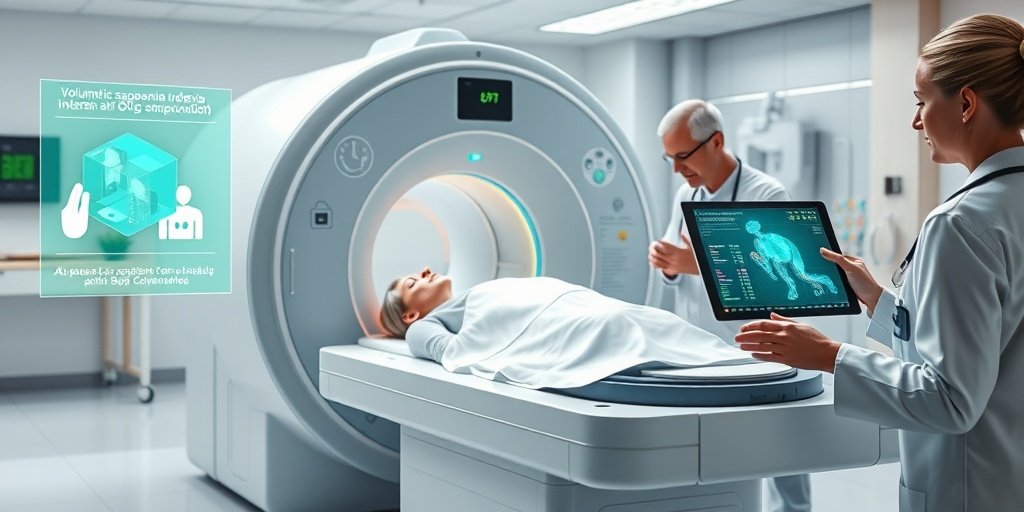⚡ Quick Summary
This study evaluated the CT-based volumetric sarcopenia index (SI) as a prognostic factor for overall survival in 10,340 solid tumor patients. The findings indicate that a higher SI is significantly associated with prolonged overall survival, highlighting its potential as a valuable tool in oncologic workflows.
🔍 Key Details
- 📊 Dataset: 10,340 solid tumor patients, 40% female
- 🧩 Features used: Automated body composition analysis of CT scans
- ⚙️ Technology: Multivariable Cox proportional hazards regression, accelerated failure time models, gradient-boosted machine learning
- 🏆 Performance: Higher SI associated with HR 0.56 (internal abdomen) and HR 0.40 (thorax)
🔑 Key Takeaways
- 📊 Sarcopenia index (SI) is a promising prognostic factor for cancer survival.
- 💡 Higher SI correlates with prolonged overall survival across multiple cohorts.
- 👩🔬 Automated analysis of CT scans enhances the accuracy of body composition assessments.
- 🏆 Machine learning models identified SI as the most critical factor in survival prediction.
- 🌍 External validation confirmed the robustness of SI as a prognostic tool.
- 📈 Significant metrics: HR 0.56 (internal abdomen), HR 0.40 (thorax), HR 0.56 (external validation).
- 🆔 Study published in NPJ Digital Medicine, 2025.

📚 Background
Sarcopenia, the loss of muscle mass and strength, has emerged as a critical factor in cancer prognosis. Traditional methods of assessing body composition can be time-consuming and subjective. This study leverages automated CT body composition analysis to provide a more objective and efficient means of evaluating sarcopenia, potentially transforming prognostic stratification in oncology.
🗒️ Study
Conducted with a large cohort of 10,340 solid tumor patients, this study utilized automated body composition analysis on baseline CT scans of the abdomen and thorax. The aim was to assess the prognostic value of the sarcopenia index (SI) in predicting overall survival, employing advanced statistical and machine learning techniques for analysis.
📈 Results
The results demonstrated that a higher SI was significantly associated with prolonged overall survival. Specifically, the internal abdomen cohort showed a hazard ratio (HR) of 0.56 (95% CI 0.52-0.59; P < 0.001), while the thorax cohort had an HR of 0.40 (95% CI 0.37-0.43; P < 0.001). External validation with an additional 439 patients confirmed these findings, with an HR of 0.56 (95% CI 0.41-0.79; P < 0.001).
🌍 Impact and Implications
The implications of this study are profound. By integrating the sarcopenia index into standard oncologic workflows, healthcare providers can enhance prognostic stratification, leading to more personalized treatment plans. This automated approach not only improves efficiency but also ensures that critical body composition metrics are consistently evaluated, potentially improving patient outcomes in cancer care.
🔮 Conclusion
This study highlights the transformative potential of automated body composition analysis in oncology. The sarcopenia index emerges as a vital prognostic tool, offering a reliable method for predicting overall survival in cancer patients. As we continue to explore the integration of technology in healthcare, the future looks promising for enhancing patient care through data-driven insights.
💬 Your comments
What are your thoughts on the role of sarcopenia in cancer prognosis? We would love to hear your insights! 💬 Leave your comments below or connect with us on social media:
Leveraging Sarcopenia index by automated CT body composition analysis for pan cancer prognostic stratification.
Abstract
This study evaluates the CT-based volumetric sarcopenia index (SI) as a baseline prognostic factor for overall survival (OS) in 10,340 solid tumor patients (40% female). Automated body composition analysis was applied to internal baseline abdomen CTs and to thorax CTs. SI’s prognostic value was assessed using multivariable Cox proportional hazards regression, accelerated failure time models, and gradient-boosted machine learning. External validation included 439 patients (40% female). Higher SI was associated with prolonged OS in the internal abdomen (HR 0.56, 95% CI 0.52-0.59; P < 0.001) and thorax cohorts (HR 0.40, 95% CI 0.37-0.43; P < 0.001), as well as in the external validation cohort (HR 0.56, 95% CI 0.41-0.79; P < 0.001). Machine learning models identified SI as the most important factor in survival prediction. Our results demonstrate SI's potential as a fully automated body composition feature for standard oncologic workflows.
Author: [‘Borys K’, ‘Haubold J’, ‘Keyl J’, ‘Bali MA’, ‘De Angelis R’, ‘Boni KB’, ‘Coquelet N’, ‘Kohnke J’, ‘Baldini G’, ‘Kroll L’, ‘Schramm S’, ‘Stang A’, ‘Malamutmann E’, ‘Kleesiek J’, ‘Kim M’, ‘Kasper S’, ‘Siveke JT’, ‘Wiesweg M’, ‘Merkel-Jens A’, ‘Schaarschmidt BM’, ‘Gruenwald V’, ‘Bauer S’, ‘Oezcelik A’, ‘Bölükbas S’, ‘Herrmann K’, ‘Kimmig R’, ‘Lang S’, ‘Treckmann J’, ‘Stuschke M’, ‘Hadaschik B’, ‘Umutlu L’, ‘Forsting M’, ‘Schadendorf D’, ‘Friedrich CM’, ‘Schuler M’, ‘Hosch R’, ‘Nensa F’]
Journal: NPJ Digit Med
Citation: Borys K, et al. Leveraging Sarcopenia index by automated CT body composition analysis for pan cancer prognostic stratification. Leveraging Sarcopenia index by automated CT body composition analysis for pan cancer prognostic stratification. 2025; 8:611. doi: 10.1038/s41746-025-02016-z